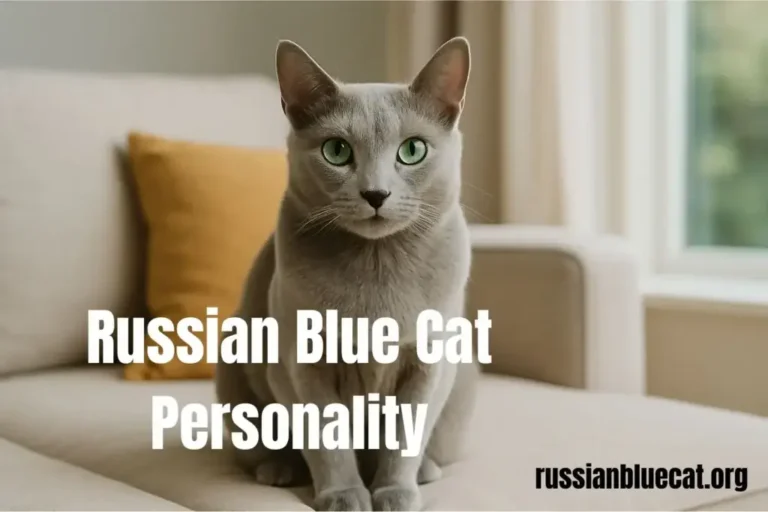Are Russian Blue Cats Hypoallergenic? 7 Facts Allergy Sufferers Must Know

Introduction – Why This Question Matters
The Russian Blue Cat is a picture of elegance shimmering silver-blue fur, piercing emerald eyes, and a quiet, dignified personality. For many cat lovers, one glance is enough to fall in love. But if you’re an allergy sufferer, the big question often isn’t about beauty or personality. Instead, it’s practical: are Russian Blue Cats hypoallergenic?
It’s a valid question since it can be complicated living with allergy and pets. No one would want to adopt a cat and end up with constant sneezing, watery eyes, or worse, asthma attacks. In this guide, we will examine why Russian Blues are known to be allergy-friendly, how they differ, and how you can cope with allergies when you have this incredible breed.
Understanding Cat Allergies – The Science Behind Sneezes
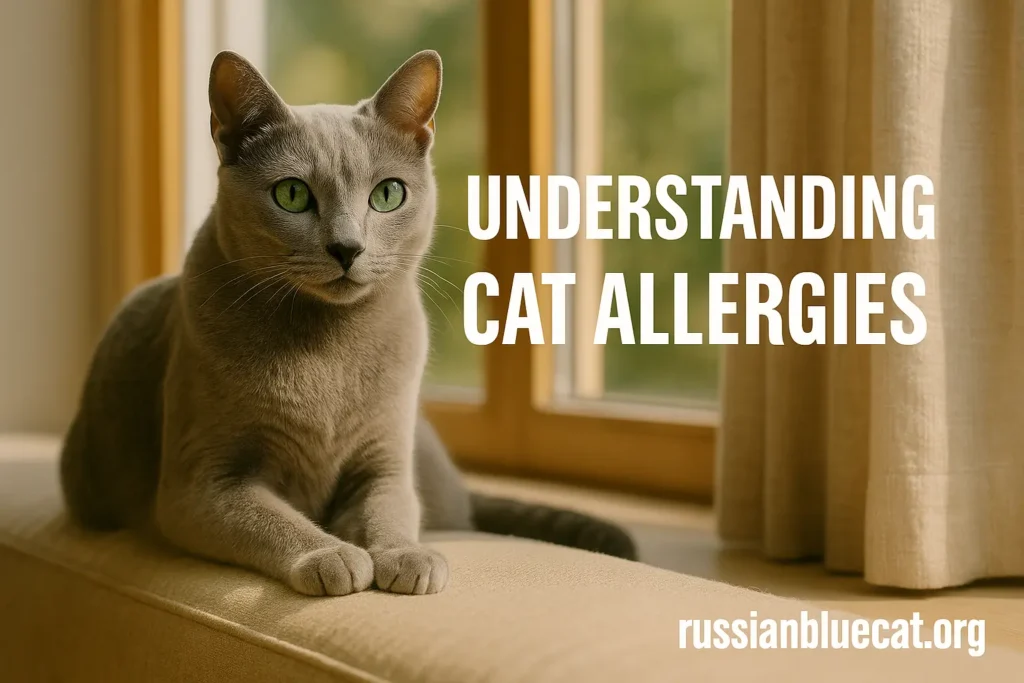
To even answer if Russian Blue Cats are hypoallergenic, first we must know why cats make us allergic.
The Perpetrator: Fel d 1 Protein
Allergies to cats result from a protein known as Fel d 1. It is not the hair itself but what sticks to it. Fel d 1 occurs in:
- Cat saliva (distributed when they lick themselves)
- Sebaceous glands within the skin
- Dander (small bits of skin)
- Urine
When cats clean themselves, saliva evaporates on their fur, releasing Fel d 1 into the air. Those tiny particles hang around the house and cause allergic reactions.
Symptoms of a Common Allergy
Individuals have varying reactions, but common signs are:
- Sneezing or runny nose
- Itchy, watery eyes
- Rashes or hives on the skin
- Wheezing or labored breathing
- Worsening asthma
For a person with mild allergies, this could simply be an annoyance. For others, it could be a relationship-breaker for pet ownership.
Why Russian Blue Cats are Allergy-Friendly
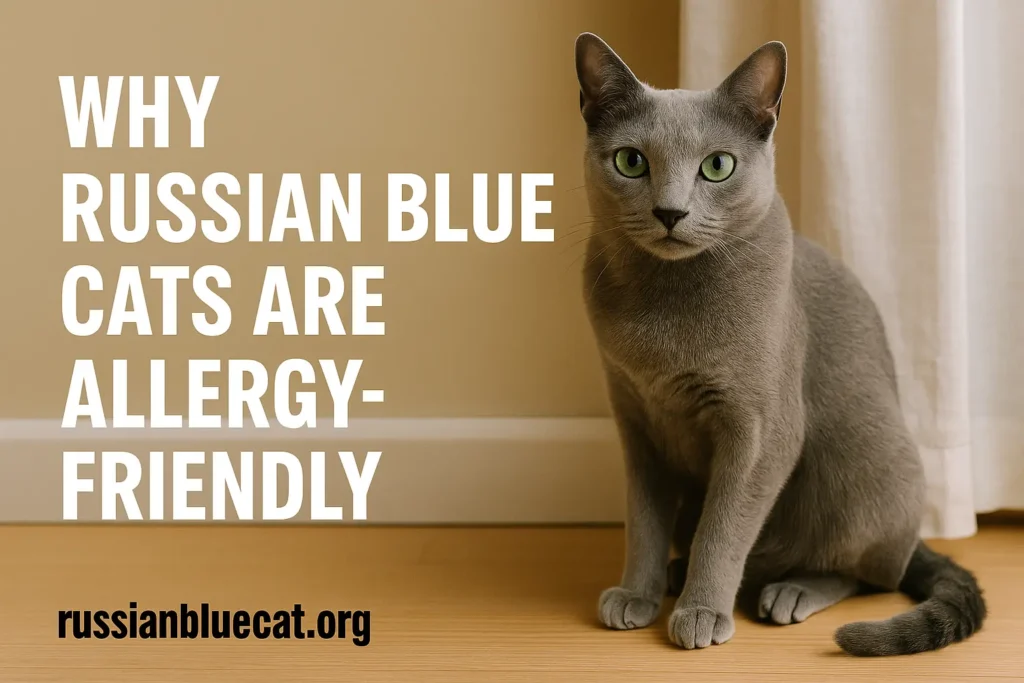
Now let’s get back to our initial question: are Russian Blue Cats hypoallergenic? Although no cat is completely allergen-free, Russian Blues are special for a number of reasons.
1. Lower Fel d 1 Levels
Numerous owners and some research indicate Russian Blues shed less Fel d 1 protein than the majority of other breeds. Less protein results in fewer allergens dispersing into your world.
2. Dense Double Coat
Their double coat is thick and plush, enclosing dander near the skin so it doesn’t float around as freely in the air. This doesn’t remove allergens, but it limits the amount that’s released into your house.
3. Natural Cleanliness
Russian Blues are notoriously clean. They groom frequently, stay sleek, and even like tidy litter boxes. A clean cat usually equals less stray dander in the air.
4. Calm Temperament
Unlike high-energy cats that fly off the walls, Russian Blues are shy and quiet. This can translate into less flying fur and less allergen in the air.
Russian Blue Cats: Are They Hypoallergenic? Cutting Through Myth and Legend
It’s crucial to dispel common myths.
- Myth: Russian Blue Cats are not allergic at all.
Reality: They still release Fel d 1. Allergy-prone people can still react. - Myth: If you adopt a kitten, you won’t have allergies.
Truth: All cats, including kittens, shed allergens. Levels may vary as they grow. - Myth: Bathing eradicates allergens.
Truth: Bathing can temporarily lower allergens, yet cats secrete Fel d 1 on an ongoing basis.
So, are Russian Blue Cats hypoallergenic? They are low-allergen but not allergen-free.
Comparing Russian Blues with Other “Hypoallergenic” Breeds
If you’re seeking a cat but are concerned about allergies, you might be curious about how Russian Blues stack up compared to others.
- Siberians: Big, long-coated cats, surprisingly low in Fel d 1.
- Balinese: Nicknamed the “hypoallergenic Siamese,” they’re talkative and loving.
- Bengals: Sleek coats shed less dander but they’re high energy.
- Devon Rex & Cornish Rex: Bare minimum of fur but require regular baths.
Russian Blues balance beauty, low allergen levels, and ease of care. They’re less demanding than Rex breeds and more elegant than many others.
Practical Tips for Allergy Sufferers with Russian Blue Cats
If you’ve decided a Russian Blue is worth the risk, here’s how to make life with them easier.
Grooming Routine
- Brush 2–3 times per week.
- Use grooming wipes to reduce dander.
- Avoid bathing unless necessary.
Cleaning Your Home
- Vacuum weekly with a HEPA vacuum.
- Wash curtains, bedding, and soft furnishings regularly.
- Utilize an air purifier in main living areas.
Personal Habits
- Wash hands after stroking your cat.
- Don’t allow your cat to sleep on your pillow.
- Change clothes after excessive cuddle time.
Allergy Aids
- Experiment with anti-allergen sprays for fabrics.
- Consider over-the-counter antihistamines if your doctor recommends them.
- Keep your immune system up to speed with healthy habits.
The Role of Nutrition in Coat and Allergen Control
Diet does not alter Fel d 1 levels directly, but nutritional diet enhances coat and skin health. Healthier coat equals reduced shedding and dander.
What to Feed a Russian Blue
- Protein foods (chicken, turkey, salmon)
- Omega-3 fatty acids for healthy coat
- Balanced wet and dry food for moisture
When the cat’s coat is shiny and the skin is healthy, it sheds less and maintains allergens at bay.
Lifestyle Adjustments for Comfortable Living
Living with a Russian Blue if you’re allergic usually boils down to adjustments in lifestyle.
- Establish cat-free areas (such as bedrooms).
- Isolate the litter box from living areas.
- Wear a mask or gloves when doing in-depth cleaning.
- Train your cat early so that it doesn’t jump up onto kitchen counters or beds.
Emotional Gains of Selecting a Russian Blue
Despite the necessity for precautions, the reward is enormous. Russian Blues are:
- Loyal: They form a close bond with one or two humans.
- Affectionate but independent: Ideal for humans who adore companionship but appreciate serenity.
- Quiet: They do not meow all the time, which makes them excellent for serene homes.
- Graceful: Their elegance brings tranquility to any space.
For most allergy patients, the work of management is well worth the friendship of a Russian Blue.
Russian Blue Cat Lifespan and Health – Why It Matters for Allergy Sufferers
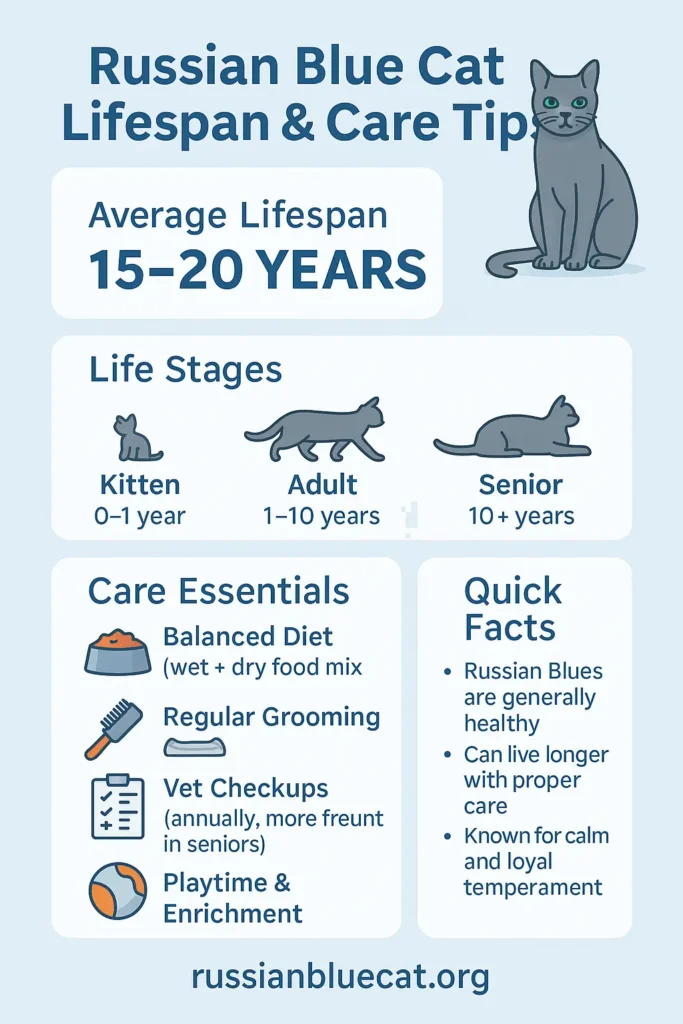
If you’re asking are Russian Blue Cats hypoallergenic, it’s not just about allergies today — it’s about what life looks like over the next 15 to 20 years.
Lifespan
Russian Blues are long-lived. With good care, their lifespan is 15–20 years, occasionally more. Which means anyone with allergies needs to think not just about immediate reactions but about long-term suitability. A fleeting sneeze this morning may be tolerable, but are you willing to coexist with those reactions for 20 years? Check our detailed guide on Russian Blue Cat Lifespan.
Health Overview
Russian Blues are a healthy breed overall, but like all cats, they have weaknesses:
- Obesity – They enjoy food, so portion control is crucial.
- Hypertrophic cardiomyopathy (HCM) – A hereditary heart condition.
- Dental conditions – Regular visits and care for teeth are critical.
Healthy cats shed less, have glossier coats, and distribute fewer allergens. Keeping healthy directly enhances comfort for allergic owners.
Grooming and Allergen Management
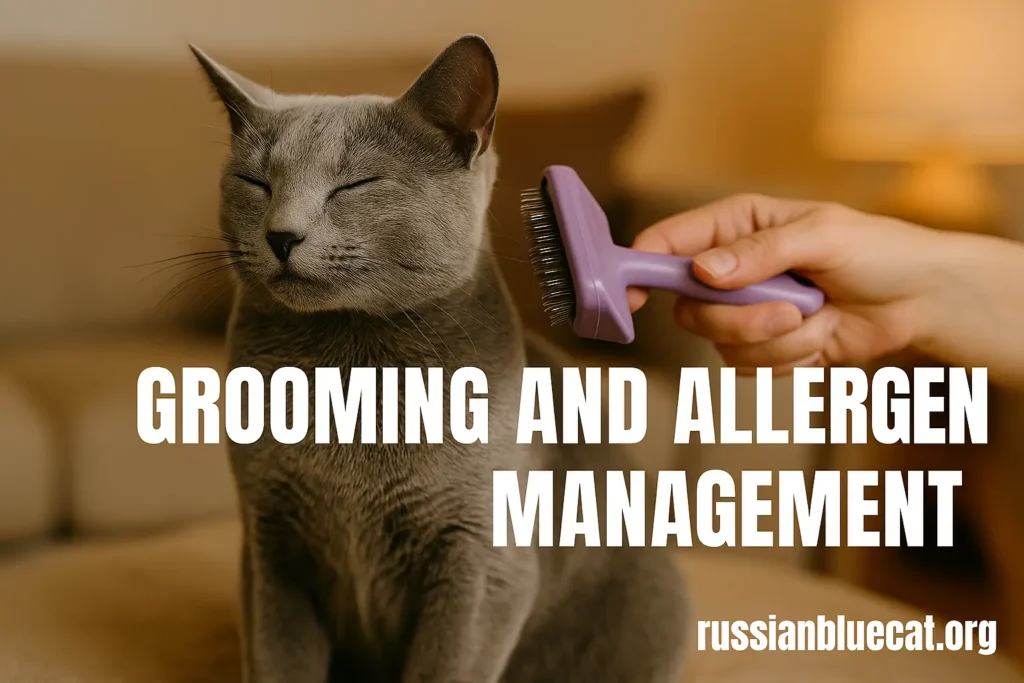
Grooming is one of the superior methods for managing allergens, particularly with a breed such as the Russian Blue.
Brushing
2–3 times weekly brushing minimizes loose hair and dander. Their dense but short coat holds particles near the body, so frequent brushing avoids allergen spreading.
Cleaning Routine
- Lint rollers: Have one in each room.
- Vacuum HEPA filter: Regular vacuums circulate allergens back into the air.
- Wash bedding & fabrics: Particularly if your cat crawls onto couches or beds.
Air Purification
Invest in a HEPA air purifier. It’s able to pick up tiny allergen particles, providing you with cleaner air to breathe.
Veterinary Insights on Russian Blue Cat Allergies
When veterinarians are questioned are Russian Blue Cats hypoallergenic, their response is guarded but optimistic.
- No Cat is Absolutely Hypoallergenic: All cats emit Fel d 1 protein.
- Russian Blues Score Low: They’re always mentioned as one of the better choices for allergy sufferers.
- Individual Variation: Every cat emits allergens to varying degrees, and each individual has a different reaction.
The American College of Allergy, Asthma & Immunology recommends allergy testing before adoption.
Adoption or Buying – What Allergy Sufferers Should Consider
If you’re convinced a Russian Blue is right for you, the next step is deciding whether to adopt or buy.
Adoption
Buying from a Breeder
Tip: Allergy sufferers should spend time with the cat before committing. Ask breeders or rescues if you can visit several times to try your sensitivity. Check our detailed guide on Russian Blue Cat Adoption & Buyer’s guide.
Life With a Russian Blue – What to Expect

Once you have your Russian Blue at home, life is a balance of love and management.
Personality
- Shy with strangers, but extremely devoted to their favorite humans.
- Quiet and laid-back, seldom loud and boisterous.
- Intelligent, loves puzzle toys and interactive games.
Family Life
- Excellent with gentle children.
- May live with other pets if introduced gradually.
- Thrives in quiet homes.
Daily Routine
- Maintain regular feeding and playtime.
- Supply scratching posts to save furniture.
- Provide quiet areas for naps.
Tips for Allergy-Friendly Living With a Russian Blue
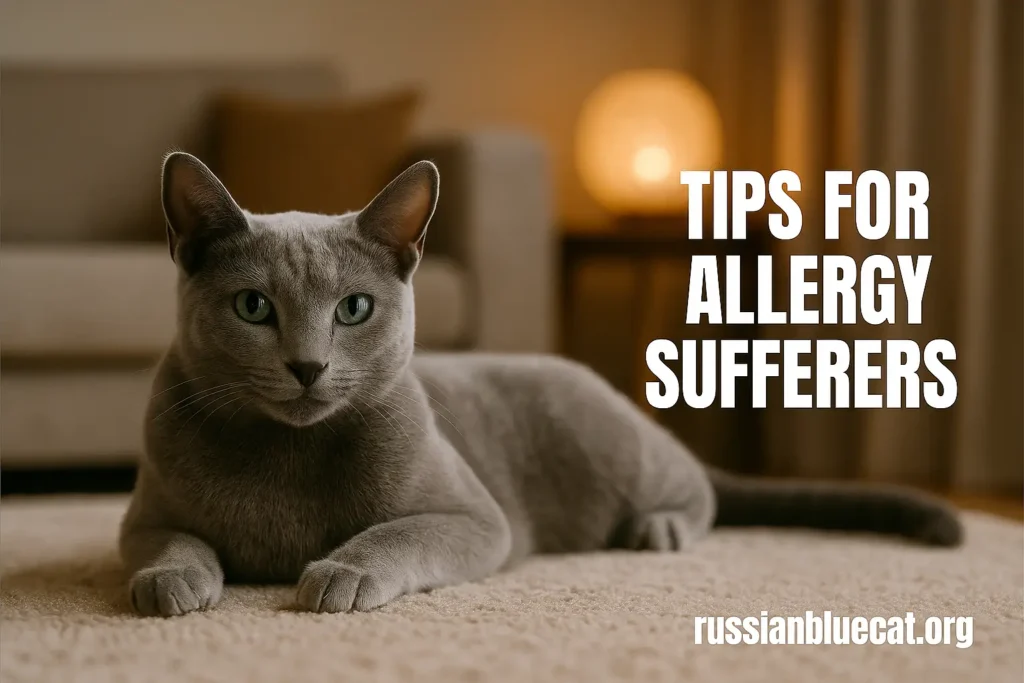
- Create Cat-Free Zones: Bedrooms are best maintained allergen-free.
- Litter Box Placement: Place out of living areas. Clean every day.
- Fabrics and Upholstery: Opt for leather or washable covers over fabric-covered furniture.
- Personal Hygiene: Wash hands after petting, change clothes if symptoms flare.
- Medication Support: If necessary, speak with your physician about allergy treatment allowing you to live comfortably.
The Emotional Payoff
Why go through all this effort if allergies make life harder? Because Russian Blue Cats offer something unique.
- They’re graceful companions. Just watching them move feels calming.
- They’re emotionally intelligent. Many owners say their Russian Blue senses moods and offers comfort.
- They’re long-term friends. With up to two decades of life, they grow with you through every stage.
When managed properly, allergies become just a small trade-off for years of loyalty and affection.
FAQs About Russian Blue Cats and Allergies
Conclusion – The Last Word
So, are Russian Blue Cats hypoallergenic?
The reality: they are not entirely 100% hypoallergenic, but they are one of the most suitable cat breeds for people who are allergic. Due to lower Fel d 1 levels, a thick coat to trap dander, and a naturally clean temperament, most individuals with mild to moderate allergies find them extremely manageable.
If you’re allergic but want to have a cat, the Russian Blue could be your ideal choice as long as you get your house ready, keep up with your cleaning schedules, and test your tolerance before settling in.
For those who are willing to make some lifestyle changes, a Russian Blue Cat will bring beauty, devotion, and tranquility into your world for 15–20 lovely years.






